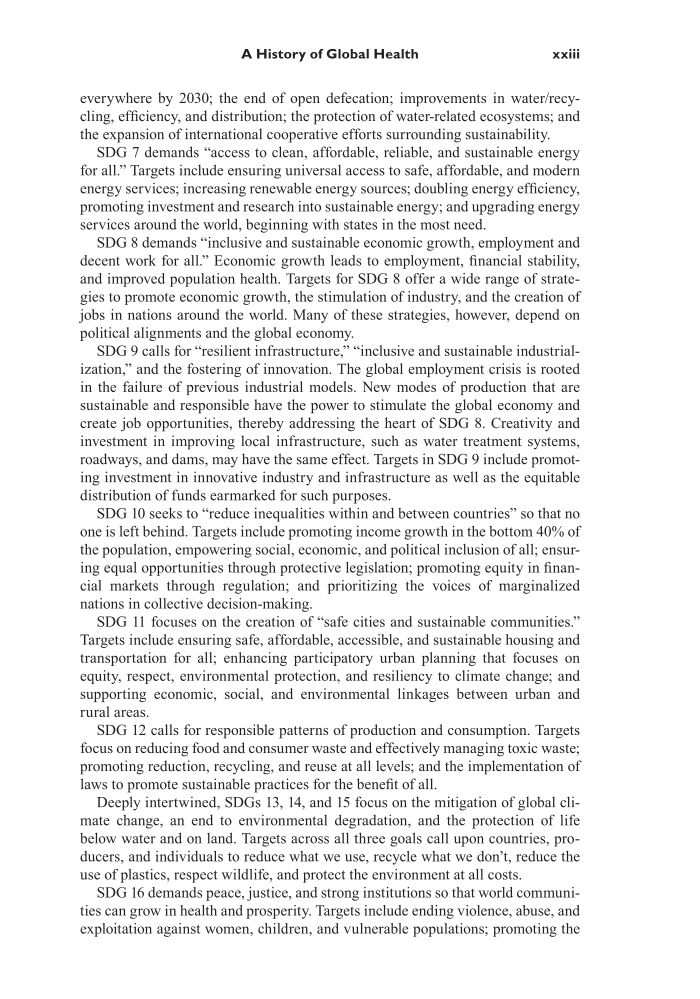A History of Global Health xxiii everywhere by 2030 the end of open defecation improvements in water/recy- cling, efficiency, and distribution the protection of water-related ecosystems and the expansion of international cooperative efforts surrounding sustainability. SDG 7 demands “access to clean, affordable, reliable, and sustainable energy for all.” Targets include ensuring universal access to safe, affordable, and modern energy services increasing renewable energy sources doubling energy efficiency, promoting investment and research into sustainable energy and upgrading energy services around the world, beginning with states in the most need. SDG 8 demands “inclusive and sustainable economic growth, employment and decent work for all.” Economic growth leads to employment, financial stability, and improved population health. Targets for SDG 8 offer a wide range of strate- gies to promote economic growth, the stimulation of industry, and the creation of jobs in nations around the world. Many of these strategies, however, depend on political alignments and the global economy. SDG 9 calls for “resilient infrastructure,” “inclusive and sustainable industrial- ization,” and the fostering of innovation. The global employment crisis is rooted in the failure of previous industrial models. New modes of production that are sustainable and responsible have the power to stimulate the global economy and create job opportunities, thereby addressing the heart of SDG 8. Creativity and investment in improving local infrastructure, such as water treatment systems, roadways, and dams, may have the same effect. Targets in SDG 9 include promot- ing investment in innovative industry and infrastructure as well as the equitable distribution of funds earmarked for such purposes. SDG 10 seeks to “reduce inequalities within and between countries” so that no one is left behind. Targets include promoting income growth in the bottom 40% of the population, empowering social, economic, and political inclusion of all ensur- ing equal opportunities through protective legislation promoting equity in finan- cial markets through regulation and prioritizing the voices of marginalized nations in collective decision-making. SDG 11 focuses on the creation of “safe cities and sustainable communities.” Targets include ensuring safe, affordable, accessible, and sustainable housing and transportation for all enhancing participatory urban planning that focuses on equity, respect, environmental protection, and resiliency to climate change and supporting economic, social, and environmental linkages between urban and rural areas. SDG 12 calls for responsible patterns of production and consumption. Targets focus on reducing food and consumer waste and effectively managing toxic waste promoting reduction, recycling, and reuse at all levels and the implementation of laws to promote sustainable practices for the benefit of all. Deeply intertwined, SDGs 13, 14, and 15 focus on the mitigation of global cli- mate change, an end to environmental degradation, and the protection of life below water and on land. Targets across all three goals call upon countries, pro- ducers, and individuals to reduce what we use, recycle what we don’t, reduce the use of plastics, respect wildlife, and protect the environment at all costs. SDG 16 demands peace, justice, and strong institutions so that world communi- ties can grow in health and prosperity. Targets include ending violence, abuse, and exploitation against women, children, and vulnerable populations promoting the
Document Details My Account Print multiple pages
Print
You have printed 0 times in the last 24 hours.
Your print count will reset on at .
You may print 0 more time(s) before then.
You may print a maximum of 0 pages at a time.















































































































































































































































































































































































































































































































































































































































































































































































































































































































































































































































































































